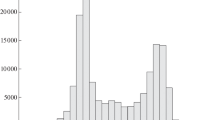Abstract—
Continuing our earlier publication, this paper presents estimates (based on our database, which included more than 1 500 000 analyses of melt inclusions and chilled glasses of rocks for 75 elements, as of 2017) of the mean concentrations of volatile, major, and trace elements in silicic magmatic rocks (SiO2 > 66 wt %) in the Earth’s dominant geodynamic setting. Three settings were examined for silicic compositions: III and IV are settings related to subduction processes (III are zones of island-arc magmatism on the oceanic crust; and IV are zones of magmatism in active continental margins, with magma-generating regions involving continental crust), and V is continental rifts and continental hotspots. For each geodynamic setting, mean concentrations of the elements and confidence levels are first calculated in three variants: for mineral-hosted melt inclusions, for chilled glasses in rocks, and for all available data. Systematic differences are determined for the mean compositions of melt inclusions and glasses in rocks for these geodynamic settings. Patterns of primitive mantle-normalized mean concentrations of elements in magmatic melts are constructed for each of the settings. The ratios of some of the elements and volatile compounds (H2O/Ce, K2O/Cl, La/Yb, Nb/U, Ba/Rb, Ce/Pb, etc.) are compared in silicic and mafic melts. Variations in the ratios of the concentrations of Th, one of the most incompatible elements, to other elements in silicic and mafic rocks are discussed.






Similar content being viewed by others
REFERENCES
M. G. Barth, S. F. Foley, and I. Horn, “Partial melting in Archean subduction zones: constraints from experimentally determined trace element partition coefficients between eclogitic minerals and tonalitic melts under upper mantle conditions,” Precambrian Res. 113, 323–340 (2002).
J. D. Clemens and G. Stevens, “What controls chemical variation in granitic magmas?” Lithos 134–135, 317–329 (2012).
P. Condamine and E. Medard, “Experimental melting of phlogopite–bearing mantle at 1 GPa: Implications for potassic magmatism,” Earth Planet. Sci. Lett. 397, 80–92 (2014).
G. N. Eby, “Chemical subdivision of the A-type granitoids: petrogenetic and tectonic implications,” Geology 20 (7), 641–644 (1992).
L. M. Forsythe, R. L. Nielsen, and M. R. Fisk, “High–field–strength element partitioning between pyroxene and basaltic to dacitic magmas,” Chem. Geol. 117, 107–125 (1994).
A. Gale, C. A. Dalton, C. H. Langmuir, Y. Su, and J.‑G. Schilling, “The mean composition of ocean ridge basalts,” Geochem. Geophys. Geosystems. 14, (2013).:https://doi.org/10.1029/2012GC004334
M. P. Gorton, and E. S. Schandl, “From continents to island arcs: a geochemical index of tectonic setting for arc–related and within–plate felsic to intermediate volcanic rocks,” Can. Mineral. 38, 1065–1073 (2000).
M. Hilyard, R. L.Nielsen, J. S. Beard, A. Patino–Douce, and J. Blencoe, “Experimental determination of the partitioning behavior of rare earth and high field strength elements between pargasitic amphibole and natural silicate melts,” Geochim. Cosmochim. Acta 64 (6), 1103–1120 (2000).
F. Huang, C. C. Lundstrom, and W. F. McDonough, “Effect of melt structure on trace–element partitioning between clinopyroxene and silicic, alkaline, aluminous melts,”. Am. Mineral. 91, 1385–1400 (2006).
V. I. Kovalenko, V. B. Naumov, A. V. Girnis, V. A. Dorofeeva, and V. V. Yarmolyuk, “Estimation of the average contents of the H2O, Cl, F, and S in the depleted mantle on the basis of the compositions of melt inclusions and quenched glasses of mid–oceanic ridge basalts,” Geochem. Int. 44 (3), 209–231 (2006).
V. I. Kovalenko, V. B. Naumov, A. V. Girnis, V. A. Dorofeeva, and V. V. Yarmolyuk, “Average compositions of magmas and mantle sources of mid-ocean ridges and intraplate oceanic and continental settings estimated from the data on melt inclusions and quenched glasses of basalts,” Petrology 15 (4), 335–368 (2007).
D. Landwehr, J. Blundy, E. M. Chamorro-Perez, E. Hill, and B. Wood, “U-series disequilibria generated by partial melting of spinel lherzolite,” Earth Planet. Sci. Lett. 188, 329–348 (2001).
R. H. Nandedkar, N. Hurlimann, P. Ulmer, and O. Muntener, “Amphibole–melt trace element partitioning of fractionating calc–alkaline magmas in the lower crust: an experimental study,” Contrib. Mineral. Petrol. 171 (71), 1–25 (2016).
V. B. Naumov, V. I. Kovalenko, V. A. Dorofeeva, and V. V. Yarmolyuk, “Average concentrations of major, volatile, and trace elements in magmas of various geodynamic settings,” Geochem. Int. 42 (10), 977–987 (2004).
V. B. Naumov, V. I. Kovalenko, V. A. Dorofeeva, A. V. Girnis, and V. V. Yarmolyuk, “Average compositions of igneous melts from main geodynamic settings according to the investigation of melt inclusions in minerals and quenched glasses of rocks,” Geochem. Int. 48 (12), 1185–1207 (2010).
V. B. Naumov, V. A. Dorofeeva, A. V. Girnis, and V. V. Yarmolyuk, “Mean concentrations of volatile components, major and trace elements in magmatic melts in major geodynamic environments on Earth. I. Mafic melts,” Geochem. Int. 55 (7), 629–653 (2017).
H. Palme and H. St. C. O’Neill, “Cosmochemical estimates of mantle composition,” Treatise Geochem. 3, 1–39 (2014).
J. A. Pearce, N. B. W.Harris, and A. G. Tindle, “Trace element discrimination diagrams for the tectonic interpretation of granitic rocks,” J. Petrol. 25, 956–983 (1984).
R. L. Rudnick and S. Gao, “Composition of the continental crust,” Treatise Geochem. 4, 1–51 (2014).
G. Van den Bleeken and K.T. Koga, “Experimentally determined distribution of fluorine and chlorine upon hydrous slab melting, and implications for F–Cl cycling through subduction zones,” Geochim. Cosmochim. Acta 171, 353–373 (2015).
W. M. White and E. M. Klein, “Composition of the oceanic crust,” Treatise Geochem. 4, 457–496 (2014).
ACKNOWLEDGMENTS
The authors thank N.L. Mironov for discussion of the results and valuable comments and suggestions concerning the manuscript.
Author information
Authors and Affiliations
Corresponding authors
Additional information
Translated by E. Kurdyukov
Rights and permissions
About this article
Cite this article
Naumov, V.B., Dorofeeva, V.A., Girnis, A.V. et al. Mean Concentrations of Volatile Components and of Major and Trace Elements in Magmatic Melts of the Dominant Geodynamic Settings of the Earth. II. Silicic Melts. Geochem. Int. 57, 407–423 (2019). https://doi.org/10.1134/S0016702919040086
Received:
Revised:
Accepted:
Published:
Issue Date:
DOI: https://doi.org/10.1134/S0016702919040086




